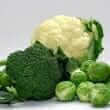Background
- Brassica oleracea belongs to the Brassicaceae (Cruciferae) family. The wild form of the plant originated along the Atlantic seaboard of Western Europe and along the Mediterranean basin. Brassica oleracea has been cultivated as a vegetable for more than 2,500 years, and through selective breeding, particular characteristics of the plant have been developed. A number of types of vegetables have been derived from this wild stock through selection of favorable cultivars. Colewort (cole-plant) is the wild form; its basic domesticated forms are collard, which has enlarged leaves, and kale, which typically has curled leaves. Cabbage is another variety, whose terminal bud consists of enlarged leaves in a tight mass (a head of cabbage). Brussels sprouts are lateral buds, which appear as miniature tight forms of cabbage, and kohlrabi are the enlarged stems. Broccoli and cauliflower are inflorescences, which are clusters of flower buds atop a stem.
- The Brassica vegetables have many nutrients and bioactive substances, such as vitamins, minerals, fiber, carotenoids, bioflavonoids, sulfur, dithiolethiones, and glucosinolates. The Brassica vegetables, especially cabbage, can withstand extremely cold temperatures. Thus, cabbage is a diet staple in many countries.
- Ethnic folk healers from the Hispanic and African-American communities have long used cabbage juice for yeast infections. Other traditional uses of cabbage include as a treatment for gout and rheumatism, and as a poultice to cleanse infected wounds.
- Good scientific evidence supports the use of Brassica
oleracea for treating breast engorgement in breastfeeding women. Clinical studies in humans have also investigated the potential beneficial effects of Brassica vegetables for cancer prevention, and for various conditions, such as high cholesterol and high triglycerides, fibromyalgia, and Helicobacter pylori infection.
References
Natural Standard developed the above evidence-based information based on a thorough systematic review of the available scientific articles. For comprehensive information about alternative and complementary therapies on the professional level, go to . Selected references are listed below
- Blomhoff R. Dietary antioxidants and cardiovascular disease. Curr Opin Lipidol 2005;16(1):47-54.
View Abstract - Bramwell B, Ferguson S, Scarlett N, et al. The use of ascorbigen in the treatment of fibromyalgia patients: a preliminary trial. Altern Med Rev 2000;5(5):455-462.
View Abstract - Galan MV, Kishan AA, Silverman AL. Oral broccoli sprouts for the treatment of Helicobacter pylori infection: a preliminary report. Dig Dis Sci 2004;49(7-8):1088-1090.
View Abstract - Hakooz N, Hamdan I. Effects of dietary broccoli on human in vivo caffeine metabolism: a pilot study on a group of Jordanian volunteers. Curr Drug Metab 2007;8(1):9-15.
View Abstract - Nikodem VC, Danziger D, Gebka N, et al. Do cabbage leaves prevent breast engorgement? A randomized, controlled study. Birth 1993;20(2):61-64.
View Abstract - Palacin A, Cumplido J, Figueroa J, et al. Cabbage lipid transfer protein Bra o 3 is a major allergen responsible for cross-reactivity between plant foods and pollens. J Allergy Clin Immunol 2006;117(6):1423-1429.
View Abstract - Roberts KL, Reiter M, Schuster D. Effects of cabbage leaf extract on breast engorgement. J Hum Lact 1998;14(3):231-236.
View Abstract - Roberts KL, Reiter M, Schuster DA. A comparison of chilled and room temperature cabbage leaves in treating breast engorgement. J Hum Lact 1995;11(3):191-194.
View Abstract - Roberts KL. A comparison of chilled cabbage leaves and chilled gelpaks in reducing breast engorgement. J Hum Lact 1995;11(1):17-20.
View Abstract - Shapiro TA, Fahey JW, Dinkova-Kostova AT, et al. Safety, tolerance, and metabolism of broccoli sprout glucosinolates and isothiocyanates: a clinical phase I study. Nutr Cancer 2006;55(1):53-62.
View Abstract - Snowden HM, Renfrew MJ, et al. Treatments for breast engorgement during lactation. Cochrane Database Syst Rev 2001;(2):CD000046.
View Abstract - Steinkellner H, Rabot S, Freywald C, et al. Effects of cruciferous vegetables and their constituents on drug metabolizing enzymes involved in the bioactivation of DNA-reactive dietary carcinogens. Mutat Res 2001;480-481:285-297.
View Abstract - Takai M, Suido H, Tanaka T, et al. [LDL-cholesterol-lowering effect of a mixed green vegetable and fruit beverage containing broccoli and cabbage in hypercholesterolemic subjects]. Rinsho Byori 2003;51(11):1073-1083.
View Abstract - Thomas M, Weisman SM. Calcium supplementation during pregnancy and lactation: effects on the mother and the fetus. Am J Obstet Gynecol 2006;194(4):937-945.
View Abstract - Whanger PD. Selenium and its relationship to cancer: an update. Br J Nutr 2004;91(1):11-28.
View Abstract







